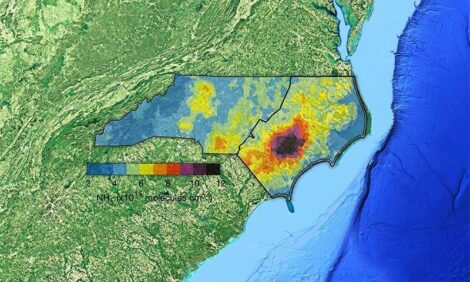



Swine Transport Biosecurity Programme
By DAHS - The importance of biosecurity for all vehicles associated with pig production cannot be stressed enough. This applies especially to livestock and feed vehicles, but also to any others visiting pig premises.Livestock haulage and other vehicles, such as feed lorries, provide an excellent vector through which disease can spread. The following table illustrates some important examples, and includes details of the independently proven efficacy of DAHS Virkon® S:

Cleaning and disinfection must be carried out to minimise the possibility of transmission of disease such as these.
Our unique Transport Biosecurity programme provides pig farmers and hauliers with step-bystep procedures to follow which if adhered to can help reduce disease transmission via transportation of livestock:
Vehicle Disinfection Summary
In addition to livestock haulage vehicles all vehicles e.g. feed lorries and contractors must follow this summary to reduce the potential for transmission of disease.
-
Only essential vehicles may enter the site.
-
All vehicles visiting the unit should be kept outside the biosecurity perimeter if at all possible.
-
Vehicles should be thoroughly cleaned and disinfected using the DAHS Vehicle Biosecurity Programme prior to arrival at the unit.
-
Wheels, tyres and wheel arches should be cleaned and disinfected upon arrival at the unit using wheel dips or sprays where provided.
-
Personnel should use footdips, protective clothing and the DAHS Hand Hygiene System prior to entry to premises
Cleansing & Disinfecting Agents

Vehicle Cleansing and Disinfection Procedures
-
Before undertaking the following biosecurity programme please ensure that the person carrying out the procedure is wearing clean and disinfected protective clothing. Protective face visor, respiratory mask and rubber gauntlets must be worn during the disinfection stage of this procedure.
STAGE 1. Dry Cleaning – Removing Organic Soiling
It is essential to remove all gross organic soiling from the vehicle as dung and refuse contain high levels of contamination and are a major source of infection. Using brushes, shovels, forks or a mechanical scraper ensure the following areas are covered:
Inside the Transporter
-
Starting on the top deck then working down, first scrape out all soiled bedding and refuse, then brush the floors, sidewalls and division gates of the trailer ensuring that any organic material is removed from the feed and water delivery pipes.
-
Ensure that any gross organic material is removed from the tail lift/ramp and gates of the truck by scraping and brushing.
-
Particular attention must be paid to the removal of organic material from the underside of the vehicle where deposits can build up. Using a stiff hand brush (or pressure washer where necessary), ensure that any deposits of mud, straw etc are removed from the wheels, wheel arches, tyres, mudguards and exposed chassis of the vehicle.
STAGE 2. Cleaning & Sanitizing
Following the removal of the soiled bedding and refuse, high levels of infective material will still remain. Cleaning with DAHS Biosolve™ at a dilution of 1:100 for spraying or 1:50 for foaming will ensure that greasy deposits do not remain on any surfaces. Using a detergent such as Biosolve™ also reduces the time taken to clean by up to 60%, and reduce the spread of disease in washing water.
Apply with either a knapsack sprayer or pressure washer using the appropriate application rate (500ml/sq.m for normal application 250ml/sq.m for foam application). If using a pressure washer, ensure that it is set on a low pressure setting ( approx. 500 psi :35 bar) using a 45º angle jet.
-
Using the brush attachment for the pressure washer, start at the top and work down each side of the cab and trailer working the Biosolve solution into the surfaces and any orifices.
-
Using the lance attachment at low pressure apply Biosolve™ to the wheels, wheel arches, tyres, mudguards and underside of the vehicle.
-
Inside the trailer, starting on the top deck and working down to the bottom, ensure that the ceiling, sides, divisions and floors are all treated thoroughly.
-
Attention must be paid to the loading ramp and tail lift and gates.
-
Ensure that all equipment stored in the belly box of the vehicle such as shovel, brush, pig board etc are removed and washed then apply Biosolve to the inside of the belly box.
-
Allow at least 10 minutes to for the detergent to penetrate and loosen the dirt from all surfaces before rinsing at high pressure.
STAGE 3. Disinfection
The level of disease organisms, particularly viruses, present after cleaning and sanitizing is still high enough to offer a serious disease challenge. The use of a broad spectrum disinfectant such as DAHS Virkon® S, active against viruses bacteria, yeasts, moulds and other pathogenic organisms and must be used to complete this effective disease control programme.
Using DAHS Virkon® S at a dilution of 1:200 solution (500 grams in each 100 litres) and rate of 300 ml/sq.m at low pressure:
-
Outside of vehicle, start at the top and work down each side.
-
Ensure that special attention is paid to the wheel arches, tyres, mudguards and underside of the vehicle.
-
Inside the vehicle, starting on the top deck and working down to the bottom, ensure that ceiling, sides, divisions and floors are disinfected thoroughly.
-
Attention must be paid to the loading ramp and tail gate lift.
-
Ensure that all washed equipment from the belly box of the vehicle such as shovel, brush, pig board etc is sprayed or soaked in DAHS Virkon® S.
-
Disinfect all internal surfaces of the belly box before returning disinfected equipment.
In very rare instances, Virkon® S may affect untreated metals, inferior or damaged galvanised metals. In these cases we recommend rinsing these areas with clean water after disinfection ensuring a contact time of at least 5 minutes.
STAGE 4. Cleaning & Disinfecting the Cab
-
Remove all removable items from the cab of the vehicle including the floor mats; clothing, Wellington boots etc, and then using a dustpan and brush remove any debris from within the cab and dispose of it into a refuse sack. Ensure that the foot pedals are free from any organic material.
-
Using a soft hand brush and a bucket of DAHS Biosolve at a dilution rate of 1:100 clean the cab floor, floor mats and foot pedals allowing at least 10 minutes for the detergent to penetrate and loosen the dirt before rinsing.
-
Using a clean cloth soaked in a solution of DAHS Virkon® S at a dilution rate of 1:100 (50 grams in 5 litres of water) disinfect the cab floor, floor mats and foot pedals.
-
Ensure that all item packed back into the cab are clean.
Finally
-
Park the vehicle on a slope to drain and dry.
-
Once the vehicle is removed from the wash area, wash down the concrete surface with Biosolve™ making sure no muck or debris remains.
-
Wash & disinfect waterproof overalls and boots.
-
For environmental awareness take care to avoid any solutions entering surface water drains or water courses. A discharge consent may be required for large volume discharges to foul sewer.







